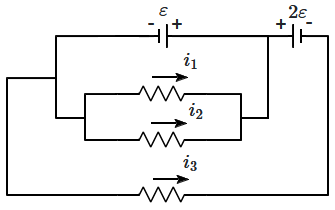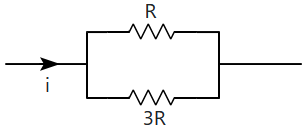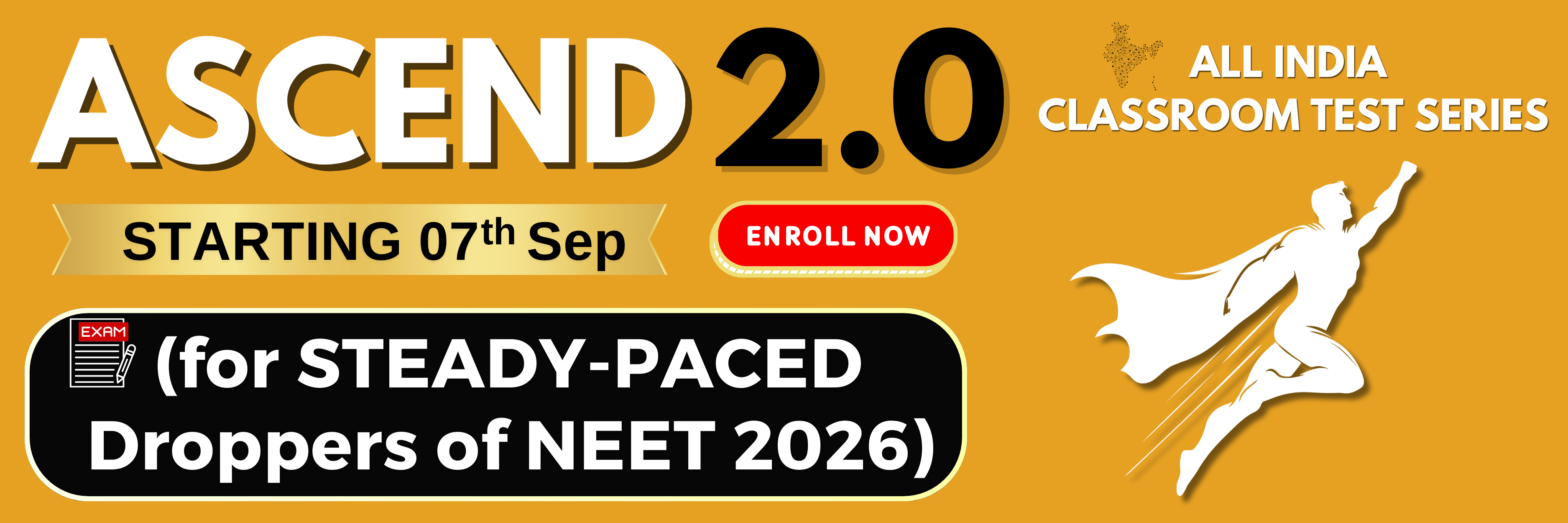Select Chapter Topics:
In the circuit shown, the equivalent resistance between terminals \(A\) and \(B\) is:

1. \(3R/2\)
2. \(2R\)
3. \(4R\)
4. \(R\)
Subtopic: Wheatstone Bridge |
89%
From NCERT
JEE
Please attempt this question first.
Hints
Please attempt this question first.
Consider the following circuit. All resistors have resistance 10 Ω each. The value of \(\left|{\frac{{i}_{1}{+}{i}_{2}}{{i}_{3}}}\right|\) is:

1. 2
2. 1
3. 3
4. 1/3

1. 2
2. 1
3. 3
4. 1/3
Subtopic: Kirchoff's Voltage Law |
Please attempt this question first.
Hints
Please attempt this question first.
Given below are two statements: one is labelled as Assertion (A) and the other is labelled as Reason (R):
In the light of the above statements choose the correct answer from the options given below:
| Assertion (A): | For making a voltmeter, we prefer a voltmeter of resistance of 4000 Ω over a voltmeter of resistance 1000 Ω. |
| Reason (R): | Voltmeter should be of higher resistance such that it draws less current from the circuit. |
In the light of the above statements choose the correct answer from the options given below:
| 1. | Both (A) and (R) are true and (R) is the correct explanation of (A). |
| 2. | Both (A) and (R) are true but (R) is not the correct explanation of (A). |
| 3. | (A) is true but (R) is false. |
| 4. | (A) is false but (R) is true. |
Subtopic: Meter Bridge |
92%
JEE
Please attempt this question first.
Hints
In the circuit shown in the figure, the internal resistances of \(5\) V and \(8\) V cells are \(3\) \(\Omega\) and 4 \(\Omega,\) respectively. The current (in amperes) flows through the 4 \(\Omega\) external resistor connected across points \(A\) and \(B\) is \(\dfrac{1}{n}~\text{A}.\)
 The value of \(n =\)
The value of \(n =\)
1. \(5\)
2. \(15\)
3. \(10\)
4. \(7\)
 The value of \(n =\)
The value of \(n =\)1. \(5\)
2. \(15\)
3. \(10\)
4. \(7\)
Subtopic: Grouping of Cells |
54%
From NCERT
JEE
Please attempt this question first.
Hints
Please attempt this question first.
A wire with a resistance of \(5~\Omega\) is stretched (redrawn) to increase its length \(5\) times. What will be the final resistance of the wire?
1. \(25~\Omega\)
2. \(16~\Omega\)
3. \(125~\Omega\)
4. \(32~\Omega\)
1. \(25~\Omega\)
2. \(16~\Omega\)
3. \(125~\Omega\)
4. \(32~\Omega\)
Subtopic: Derivation of Ohm's Law |
81%
From NCERT
JEE
Please attempt this question first.
Hints
Please attempt this question first.
A uniform wire of resistance \(R\) is folded into a regular polygon of \(n\) sides. The equivalent resistance of this system between any two adjacent points is:
1. \({{n-1}\over{n}}R\)
2. \({{n-1}\over{n^{2}}}R\)
3. \({{n-1}\over{n^{3}}}R\)
4. \({{n+1}\over{n^{2}}}R\)
1. \({{n-1}\over{n}}R\)
2. \({{n-1}\over{n^{2}}}R\)
3. \({{n-1}\over{n^{3}}}R\)
4. \({{n+1}\over{n^{2}}}R\)
Subtopic: Combination of Resistors |
79%
From NCERT
Please attempt this question first.
Hints
Please attempt this question first.
Consider the meter bridge setup shown.

If a shunt resistance is added to \(3~\Omega\) resistor, the balance point shifts by 22.5 cm. The shunt resistance is equal to:
1. \(1~\Omega\)
2. \(2~\Omega\)
3. \(3~\Omega\)
4. \(4~\Omega\)

If a shunt resistance is added to \(3~\Omega\) resistor, the balance point shifts by 22.5 cm. The shunt resistance is equal to:
1. \(1~\Omega\)
2. \(2~\Omega\)
3. \(3~\Omega\)
4. \(4~\Omega\)
Subtopic: Meter Bridge |
78%
JEE
Please attempt this question first.
Hints
In the part of a circuit shown, the ratio of the rate of heat produced in R to that in 3R is:

1. 1: 9
2. 1: 3
3. 3: 1
4. 9: 1

1. 1: 9
2. 1: 3
3. 3: 1
4. 9: 1
Subtopic: Heating Effects of Current |
71%
Please attempt this question first.
Hints
Please attempt this question first.
For the given electrical circuit, the potential difference between point \(B\) and \(C\) is zero. The value of \(x\) is:

1. \(\dfrac{1}{2}\) \(\Omega\)
2. \(\dfrac{3}{2}\) \(\Omega\)
3. \(\dfrac{2}{3}\) \(\Omega\)
4. \(\dfrac{3}{5}\) \(\Omega\)

1. \(\dfrac{1}{2}\) \(\Omega\)
2. \(\dfrac{3}{2}\) \(\Omega\)
3. \(\dfrac{2}{3}\) \(\Omega\)
4. \(\dfrac{3}{5}\) \(\Omega\)
Subtopic: Wheatstone Bridge |
79%
JEE
Please attempt this question first.
Hints
Please attempt this question first.
In the circuit shown below, the value of current \(I_1\) (in amperes) is equal to:

1. \(-{{11}\over{5}}\)
2. \({{11}\over{5}}\)
3. \(-{{5}\over{7}}\)
4. \({{5}\over{7}}\)

1. \(-{{11}\over{5}}\)
2. \({{11}\over{5}}\)
3. \(-{{5}\over{7}}\)
4. \({{5}\over{7}}\)
Subtopic: Kirchoff's Voltage Law |
Please attempt this question first.
Hints
Please attempt this question first.






